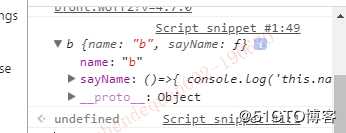深度剖析 javascript call方法实现继承的原理
2020-12-13 02:54
标签:自我 生成 转化 foo 赋值 alt this 常见 pre demo2: 我们可以看到,只需要在b中 添加 a.call(this);然后直接实例化就可以实现继承了,可是为什么呢? 我们先看下官方文档对call方法的解释: call() 提供新的 this 值给当前调用的函数/方法。 也就是说call 方法将原本a的this对象替换成了b的this对象,是不是有点绕口? 但是这样还是不能解释为什么bt 可以访问a函数内的方法,a函数内的方法只有a的实例才可以访问呀,难道a函数也被实例化了嘛???? 要搞清楚这个问题我们首先还需要知道new 这个关键字到底做了什么? function b(){ console.log(bt); 我们可以看到new 关键字创建了一个对象,将所有this关键字的属性都生成了新对象的属性; 输出: 猜测正确,所以实现继承的方式call只是起了个替换this对象的作用,主要工作还是在new 关键字,它能自动检测和this绑定的属性,全部添加到要实例化的对象上面。其实上面的代码和下面的代码效果是一样的: 今天算是对call 有了更深的理解,完全是自我理解,如果你有不同的见解,欢迎评论,欢迎打脸指正。 码字不易点个赞再走吧。 深度剖析 javascript call方法实现继承的原理 标签:自我 生成 转化 foo 赋值 alt this 常见 pre 原文地址:https://blog.51cto.com/13496570/2411590
今天没事正好好好研究一下。
call 方法最常见的也是面试问题之一是啥,对就是用call实现继承。
以下是两个简单的实现继承的例子。
demo1:function a(){
??? this.name = function(){
????? ?console.log(‘a‘,this.namevalue,this.age)
??? }
}
function b(){
??? a.call(this);??? //这里的this代表b对象本身
}
var bt = new b();
bt.name();?
function Product(name, price) {
this.name = name;
this.price = price;
}
function Food(name, price) {
Product.call(this, name, price);
this.category = ‘food‘;
}
function Toy(name, price) {
Product.call(this, name, price);
this.category = ‘toy‘;
}
var cheese = new Food(‘feta‘, 5);
var fun = new Toy(‘robot‘, 40);
this.name="b";
this.sayName=()=>{
console.log(‘this.name‘,this.name);
}
}
var bt=new b();
也就是说new关键字会将所有的和this有关的属性都会转化为新对象的属性,
那么当call方法将b的this对象赋值给a方法时,new 也会检测到:并且当做是b的属性一期实例化:让我们来试验一下。已demo1代码为例,将b输出一下:function a(){
this.namevalue=19;
??? this.name = function(){
??????console.log(‘a‘,this.namevalue,this.age)
??? }
}
function b(){
this.age=19;
??? a.call(this);??? //这里的this代表b对象本身
}
var bt = new b();
console.log(bs)
function b(){
this.namevalue=19;
??? this.name = function(){
??????console.log(‘a‘,this.namevalue,this.age)
??? }
this.age=19;
??? a.call(this);??? //这里的this代表b对象本身
}
var bs = new b();
console.log(bs)
上一篇:5.1 Java_数组的概念
下一篇:Winsock 编程流程
文章标题:深度剖析 javascript call方法实现继承的原理
文章链接:http://soscw.com/essay/26543.html